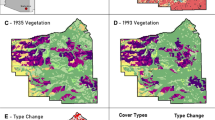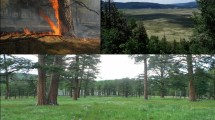Abstract
Wildfires are an important agent in driving ecosystem function by altering vegetation structure and geomorphic processes. In recent decades, the number of wildfires and the total area burned has increased around the world, causing changes to natural regimes. In this study, we compared south- and north-facing slopes, their vegetation structure and dynamics, and the sediment yield generated in areas burned a number of times at the Carmel Mountain ridge in northern Israel. Our underlying hypothesis was that repeated and frequent fires significantly alter eco-geomorphic processes, including prolonged periods of soil erosion and delayed recovery of tree species. We tested whether these phenomenon are characterized by different rates on opposing aspects. To study the long-term changes of the vegetation we analyzed a 21-year (1985–2006) chrono-sequence of satellite images, in areas burned once, twice, or three times. Additionally, we estimated vegetation structure and cover at high resolutions in monitoring plots following a fire in 2005 in areas burned once or twice during the last two decades. To evaluate the long-term dynamics of the system, specific transition probabilities among the vegetation types, as a function of the number of times each site was burned, were used to construct Markov-based transition matrices. Additionally, runoff and sediment have been collected after precipitation events from the plots. The satellite image classifications revealed changes in the composition of tree, shrub, and herbaceous vegetation cover following wildfire events. Satellite image analyses suggest that recurring fires within short-time intervals may significantly alter the long-term structure of the vegetation communities, and may eliminate woody vegetation from the landscape (both trees and shrubs). Consequently, this results in the establishment and dominance of herbaceous vegetation communities. Similar trends were observed in the high-resolution monitoring plots. Sediment yields differed significantly in areas burned twice on south-facing slopes, compared to lower values obtained in areas burned once, or located on north-facing slopes. Thus, we demonstrate that repeated fires may dramatically alter long-term trajectories of Mediterranean-type vegetation communities and ecosystems. This pattern, in turn, may have significant implications for the associated geo-morphological processes, especially runoff and erosion, and should be of particular concern given recent changes of fire regimes.






Similar content being viewed by others
References
Abdel Malak D, Pausas JD. 2006. Fire regime and post-fire Normalized Difference Vegetation Index changes in the eastern Iberian peninsula (Mediterranean basin). Int J Wildland Fire 15:407–13.
Arthur MA, Paratley RD, Blankenship BA. 1998. Single and repeated fires affect survival and regeneration of woody and herbaceous species in an oak-pine forest. J Torrey Bot Soc 125:225–36.
Bell B, Hopkins AJM, Lamont BB. 1986. Resilience in Mediterranean-type ecosystems. Dordrecht: Dr W Junk Pub Co.
Bowen BJ, Pate JS. 1993. The significance of root starch in post-fire shoot recovery of the resprouters Stirlingia latifolia R. Br. (Proteaceae). Ann Bot 72:7–16.
Callaway RM, Davis FW. 1993. Vegetation dynamics, fire, and the physical environment in Coastal Central California. Ecology 74:1567–78.
Campo J, Andreu V, Gimeno-Garcia E, Gonzalez O, Rubio JL. 2006. Occurrence of soil erosion after repeated experimental fires in a Mediterranean Environment. Geomorphology 82:376–87.
Cerdà A, Imeson AC, Calvo A. 1995. Fire and aspect induced differences on the erodibility and hydrology of soils at La Costera, Valencia, Southeast Spain. Catena, pp 289–304.
Congalton R, Green K. 1999. Assessing the accuracy of remotely sensed data: principles and practices. Boca Raton (FL): Lewis Press.
Díaz-Delgado R, Lloret F, Pons X, Terradas J. 2002. Satellite evidence of decreasing resilience in Mediterranean plant communities after recurrent wildfires. Ecology 83:2293–303.
Donato D, Fontaine J, Robinson W, Kauffman J, Law B. 2009. Vegetation response to a short interval between high-severity wildfires in a mixed-evergreen forest. J Ecol 97:142–54.
Drewa PB, Platt WJ, Moser EB. 2002. Fire effects on resprouting of shrubs in headwaters of southeastern longleaf pine savannas. Ecology 83:755–67.
ESRI. 2007. ArcGIS users manual. Redlands (CA): Environmental Systems Research Institute, Inc.
Garren KH. 1943. Effects of fire on vegetation of the southeastern United States. Bot Rev 9:617–54.
Giovannini G, Vallejo R, Lucchesi S, Bautista S, Ciompi S, Llovet J. 2001. Effects of land use and eventual fire on soil erodibility in dry Mediterranean conditions. For Ecol Manag 147:15–23.
Inbar M, Wittenberg L, Tamir M. 1998. Runoff and erosion processes after forest fire in Mount Carmel, a Mediterranean area. Geomorphology 24:17–33.
Keeley JE, Keeley SC. 1981. Post-fire regeneration of southern California chaparral. Am J Bot 68:524–30.
Keeley JE, Fotheringham CJ, Baer-Keeley M. 2005. Factors affecting plant diversity during post-fire recovery and succession of Mediterranean-climate shrublands in California, USA. Divers Distrib 11:525–37.
Kutiel P, Shaviv A. 1992. Effects of soil type, plant composition and leaching on soil nutrients following a simulated forest fire. For Ecol Manag 53:329–43.
Lahav C, Farkash M. 1986. Carmel: nature and landscape. The Israeli Society for the Protection of Nature (in Hebrew).
Laterra P, Vignolio OR, Linares MP, Giaquinta A, Maceira N. 2003. Cumulative effects of fire on a tussock pampa grassland. J Veg Sci 14:43–54.
Lavorel S. 1999. Ecological diversity and resilience of Mediterranean vegetation to disturbance. Divers Disturb 5:3–13.
Levin SA. 1992. The problem of pattern and scale in ecology. Ecology 73:1943–67.
Mayor AG, Bautista S, Llovet J, Bellot J. 2007. Post-fire hydrological and erosional responses of a Mediterranean landscape: seven years of catchment-scale dynamics. Catena 71:68–75.
Nave Z. 1990. Fire in the Mediterranean—a landscape ecological perspective. In: Goldammer JF, Jenkins MJ, Eds. Fire in ecosystems dynamics. Proceedings of the Third International Symposium in Freiburg, FRG, May 1989. Hague: SPB Academic Publishing. p 1–20.
Neâeman G, Fotheringham CJ, Keeley JE. 1999. Patch to landscape patterns in post fire recruitment of a serotinous conifer. Plant Ecol 145:135–242.
Neâeman G, Goubitz S, Nathan R. 2004. Reproductive traits of Pinus halepensis in the light of fire—a critical review. Plant Ecol 171:69–79.
Noss RF, Franklin JF, Baker WL, Schoennagel T, Moyle PB. 2006. Managing fire-prone forests in the western United. Front Ecol Environ 4:481–7.
Pate JS, Froend RH, Bowen BJ, Hansen A, Kuo J. 1990. Seedling growth and storage characteristics of seeder and resprouter species of mediterranean-type eco-systems of southwest Australia. Ann Bot 65:585–601.
Paula S, Ojeda F. 2009. Belowground starch consumption after recurrent severe disturbance in three resprouter species of the genus Erica. Botany 87:253–9.
Pausas J. 2001. Resprouting vs seeding—a Mediterranean perspective. Oikos 94:193–4.
Pausas JG, Ribeiro E, Vallejo R. 2004. Post-fire regeneration variability of Pinus halepensis in the eastern Iberian Peninsula. For Ecol Manag 203:251–9.
Pausas JG, Llovet J, Rodrigo A, Vallejo R. 2008. Are wildfires a disaster in the Mediterranean basin? A review. Int J Wildland Fire 17:713–23.
Sprugel DG. 1991. Disturbance, equilibrium, and environmental variability—what is natural vegetation in a changing environment. Biol Conserv 58:1–18.
Sternberg M, Shoshani M. 2001. Influence of slope aspect on Mediterranean woody formations: comparison of a semiarid and an arid site in Israel. Ecol Res 16:35–45.
Vanniere B, Colombaroli D, Chapron E, Leroux A, Tinner W, Magny M. 2008. Climate versus human-driven fire regimes in Mediterranean landscapes: the Holocene record of Lago dell’Accesa (Tuscany, Italy). Quat Sci Rev 27:118–1196.
Velez R. 2002. Causes of forest fire in the Mediterranean Basin. In: Arbez M, Birot I, Carnus JM, Eds. Risk management and sustainability forestry. EFI proceedings No. 45.
Visual Learning Systems. 2002. User Manual, Feature Analyst Extension for ArcView 3.2. Missoula (MT): Visual Learning Systems, Inc.
Wittenberg L, Inbar M. 2009. The role of fire disturbance on runoff and erosion processes the role of fire disturbance on runoff and erosion processes—a long-term approach, Mt. Carmel case study, Israel. Geogr Research 47:46–56.
Wittenberg L, Malkinson D. 2009. Spatio-temporal perspectives of forest fires regimes in a maturing Mediterranean mixed pine landscape. Eur J Forest Res 128:297–304.
Wittenberg L, Malkinson D, Beeri O, Halutzi A, Tessler N. 2007. Spatial and temporal patterns of vegetation recovery following sequences of forest fires in a Mediterranean landscape, Mt. Carmel Israel. Catena 71:76–83.
Author information
Authors and Affiliations
Corresponding author
Rights and permissions
About this article
Cite this article
Malkisnon, D., Wittenberg, L., Beeri, O. et al. Effects of Repeated Fires on the Structure, Composition, and Dynamics of Mediterranean Maquis: Short- and Long-Term Perspectives. Ecosystems 14, 478–488 (2011). https://doi.org/10.1007/s10021-011-9424-z
Received:
Accepted:
Published:
Issue Date:
DOI: https://doi.org/10.1007/s10021-011-9424-z




